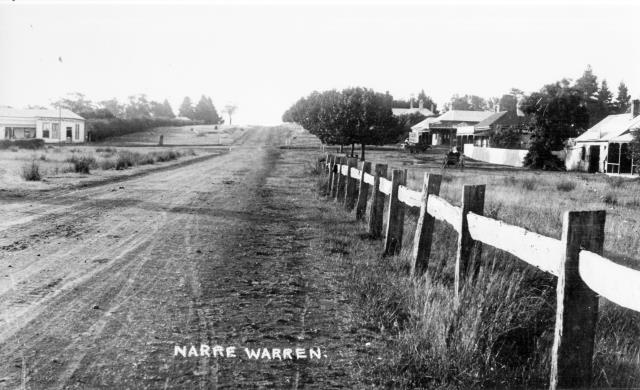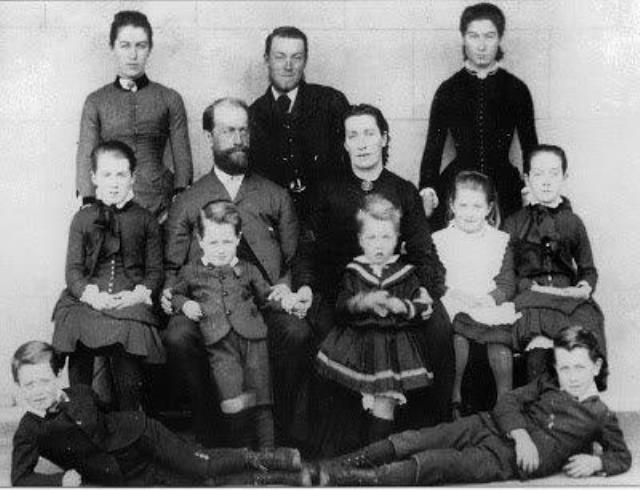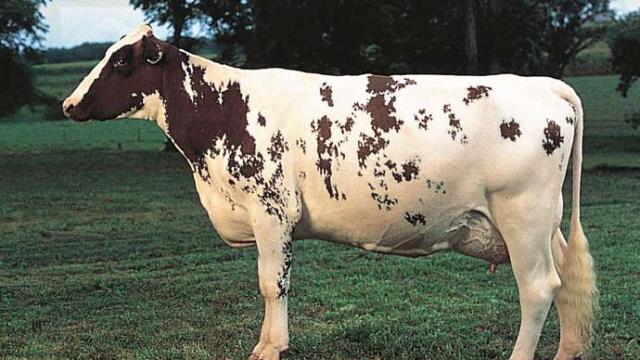Sidney Webb played a significant role in the development of Narre Warren township and now one of its main thoroughfares carries his name, as NEIL LUCAS explains in his latest look at the significance of street and place names in the region.
Sidney Webb was born in England in 1844 and travelled to Australia in the Clasmarden, arriving in Port Phillip on 10 November 1854.
Young Sidney, on leaving school, pursued a career in the newspaper industry employed as the publisher of The Age, Leader and Australian News newspapers.
Following serving 18 years with The Age newspaper, Sidney retired to operate a newsagency which he ran for many years including his founding of the Victorian Authorised Newsagents’ Association.
Sidney had done so well in his business activities that he was able to undertake a complete change in his life, and this change brought him to Narre Warren.
A large property on the north side of Princes Highway at Narre Warren (now occupied by the Fountain Gate Shopping Centre and City of Casey buildings) had become available for sale.
This farm named Holly Green was owned by Thomas Walton, who had purchased the site from one of the district’s first settlers Robert Gardiner.
In 1880 Sidney purchased the farm which fronted the Gippsland Road (Princes Highway) to the south and the Narre Warren North Road to the east.
When the Gippsland railway was constructed through the district in the late 1870s it passed through a farming district located some five kilometres south of Narre Warren for at that time, what is now known as Narre Warren North was named Narre Warren.
The coming of the railway changed all that, including the name of the locality.
Initially there was no railway station near Sidney’s property – accordingly Sidney led a successful campaign to have a station built to serve the local community.
The station was constructed further to the west of the present station and on the west side of the present Webb Street crossing. When this was achieved, access to the new station became an issue.
Sidney established a fund and encouraged local residents to contribute donations towards the purchase of land between the Gippsland Road and the new station to facilitate access. The land in question known as Roseneath was owned and farmed by Captain Wauchope.
The purchase of land for a road was achieved with funds raised in the community and the road was handed to the Shire Council.
Access was then available from the Gippsland Road to the Narre Warren railway station. However, access to the station from north of the Gippsland Road was still a problem.
The Narre Warren North Road had for many years been very boggy just to the north of the Gippsland Road where the waters of the Narre Warren Creek were retarded somewhat by the Gippsland Road.
Accordingly, through the 1880s travellers from the north skirted the boggy area through Sidney Webb’s property. Sidney’s solution was to donate a portion of his land to the council together with a contribution of 10 pounds towards the making of the road.
In March 1888 Sidney’s offer was accepted and a diversion of the Narre Warren North Road was established in line with the new road to the station that had been created through Captain Wauchope’s property.
At this time the original Narre Warren became known as Old Narre Warren and then later, Narre Warren North. Narre Warren had “stolen” its name from the town to its north.
Sidney encouraged the railway authorities to improve services to Narre Warren in a letter to the Editor of the Age in December 1887 – “As a resident of Narre Warren, which is only 24 miles from Melbourne on the same line of railway, I think that if the commissioners cannot see their way to granting the request of the deputationists, they might reasonably give a couple of extra trains daily, which could be run at a very small extra coat to the department I would suggest that the 11.30pm to Dandenong should continue the journey to Beaconsfield, stopping there for the night, instead of at Dandenong, returning next morning at 8.30. This would enable business men to reach town at a reasonable hour. At present we have to catch the 7am from Beaconsfield, which takes two and frequently two and a half hours to reach the metropolis. The 2.20pm should also be allowed to continue the journey to Beaconsfield, returning as it at present does on Saturdays. This would give our families an opportunity of spending the evening in town and get home by the 11.30pm. If the commissioners will run these trains for a time as an experiment, I will guarantee to take out £50 in periodical tickets for self and family on 1st January next, and I am sure there are many more residents that will do likewise.”
Sidney continued writing to the authorities and organising petitions for improved rail services. In 1903 it was noted in the local paper – “the 7.15am train starting again (thanks to the efforts of Mr Webb of Narre Warren who got up numerous petitions), gives great satisfaction and looks brighter for the coming season.”
Sidney and his wife Ann (also born in England) produced 14 children – Sidney 1866, Annie 1868, Amelia 1870, Howard 1871, Alice 1872, Edith 1873, Jessie 1874, Lucy 1877, Florence 1878, Henry 1880, Robert 1881, Bertha 1883, Walter 1885, and Percy 1886.
Sidney had taken over the farm established by Thomas Walton. He began cattle raising and dairying with Ayrshire and Alderney breeds on the property, growing oats and cherries in a small orchard. Initially, the farm comprised 1100 acres (445 hectares).
During the late 1880s Sidney had taken a decision to establish a sheep stud flock which he commenced with Lincoln sheep, but subsequently changed to Shropshires and imported rams from England and South Australia and Tasmania to establish and improve his stud, winning many prizes at the Royal Melbourne and other shows in Victoria. At the Narre Warren Agricultural Show, conducted by the Mornington Farmers’ Society (forerunner of the Berwick Show Society) in 1891 Sidney won prizes for his sheep.
In the 1890s, Sidney began extending the fruit growing activities on his farm planting plums, apples and pears, walnuts, Spanish chestnuts and mulberries. The large vegetable garden was extended and Sidney and Ann’s daughters became quite expert in the preservation of fruit and vegetables.
By 1902 Holly Green was grazing 600 sheep, 300 lambs, 40 head of cattle, Berkshire pigs, and a number of working horses.
In 1906 Sidney transported a number of his sheep by train to Sydney to compete in a sheep show where he succeeded in obtaining two first prizes, three seconds and one third.
One of the interesting crops grown at Holly Green was pumpkins, which Sidney found that the sheep “did well on”. Sidney was never without a supply of pumpkins for the winter. He found them easy to grow, harvest, store.
Sidney let the sheep do their own slicing. The pumpkins were carted out into the paddocks and thrown down so as to break them up. The sheep would then nibble at them until they were gone. Sidney was a keen member of the Australian Shropshire Association, serving as president for a time.
The success of Sidney’s early plantings led in 1902 to the establishment of an apple orchard comprising 15 acres (six hectares) which he later increased to 50 acres (20 hectares) planting Jonathon, Rome Beauty and Yates varieties.
By 1907 Sidney had sold 220 acres (89 hectares) of his land which had also been developed as orchards.
Sidney was a great believer in the value of draining, and sought to improve his pastures and cropping paddocks. He did this using a double-furrowed plough pulled by a team of 26 bullocks which he hired from time to time at a cost of five pounds for ploughing 50 acres (20 hectares). Sidney was also the first in the district to make use of a reaper and binder.
The Australasian newspaper reported in 1910 that Sidney also bred a few horses. In the horse line he had one or two curiosities. A pony that he used to drive round the farm was 29 years of age, and still had some pace left, while a mare which could make herself useful with light loads in a dray was only a year younger.
Sidney was community-minded and sought to do what he could to develop the area. Adjacent to the Gippsland Road, Sidney established a number of buildings which he leased to a blacksmith, butcher and a baker. With the development of a town, a school was required. Accordingly, Sidney donated land for the establishment of a school.
Many entertainment evenings were conducted over these years to raise funds for the school and other community projects.
One such evening in April 1885 was described in part as follows – “On Saturday evening, 28th ult., the anniversary of the monthly entertainments was held by the committee in the State School, which was packed with a well conducted audience. Mr. Green, who occupied the chair, stated that the committee had raised sufficient funds during the year to purchase a piano, and he hoped to see the building of a mechanics’ institute soon started. An excellent programme was provided by Messrs. S. Webb and Green, which was heartily gone through. The band, consisting of Miss Webb (piano), Messrs. Webb (violin), Moran (cornet) and Woodley (piccolo), opened with an overture. “Bide a wee“ was sweetly sung by Miss Matthews. Mr. Lewis and Miss White received ringing applause while singing the duet “Happy Policeman,“ and responded to an encore by singing the “A. B.C.“ duet. A contingent of Melbourne gentlemen, consisting of Messrs. Styles, Stacey, and Whitney, greatly added to the enjoyment of the audience, who very much appreciated the singing of Mr. Styles, that gentleman being a great favourite. The novelty of the evening was Mr. Stacey’s ventriloquial performance, which quite convulsed the meeting with laughter, as did his songs “Raspberry tart,“ and “Out on the spree.“ Mr. Styles accompanied on the piano. The dialogue “Women’s Rights“ was well rendered. The following was the programme presented:- Overture by the band; song, “Bide a wee,“ Miss Matthew; duet, “Happy policeman,“ Mr. Lewis and Miss White; dialogue, Women’s rights,“ Mrs. Harbrow, Miss Halleur, and Messrs. Engletsie and Kerr; song, “Anchored,“ Mr. Styles; selection, Misses Brown and Webb; song, “Raspberry Tart,“ Mr. Stacey; recitation, “Private Still,“ Mr. Heath; violin solo, “The last rose of summer,“ Mr. Webb; song, “Dreaming of Home.“
The Webb family certainly featured in this and other events and a regular contributor was Sidney Webb playing the violin.
At a meeting held in the school on 31 July 1890, with Sidney Webb in the chair, it was decided to erect a Mechanics’ Institute at Narre Warren. Three trustees were elected, namely: Mr. J. Sweeney, Mr. A. B. Kent, Mr. S. J. Webb. Other officers appointed were: President, Mr. A.B. Kent; vice-president, Mr. S.J. Webb; committee, Messrs. G. Taylor, J. V. Dunkinson. T.Woodley, J. Sweeney, W.N.Wauchope, E. Hillbrick, C. Hanley, C. West, S. Webb, jnr.; hon. treasurer, Mr.S.Webb, jnr.; hon. secretary, Mr.H. J. McDonnell.
Sidney Webb promised to make over a half-acre allotment of land to the trustees for the purpose of building the hall. A subscription list was opened in the room and £25/19/- was promised. An entertainment committee was formed to raise funds.
So quickly did the committee work that the hall was soon built and the opening ceremony took place on 9 November, 1891. Sidney subsequently served as secretary and treasurer for 25 years.
The Narre Warren Sports Committee, of which Sidney was a member, conducted sporting carnivals to raise funds for various causes.
A local Narre Warren Cricket Team had been formed, and in 1893 the Sports Committee arranged a sports event attended, not only by locals, but by visitors from Beaconsfield, Nar Nar Goon, Berwick and Dandenong. The local paper recorded “the sports…. we are authoritatively informed, will result in a substantial sum being handed over to the local cricket club.”
The fundraising for the school, the hall and other community purposes continued for decades, and Sidney Webb was a keen participant in these activities.
In 1911 the local paper recorded another fundraising event as follows – “A musical treat, in aid of the hall funds, consisting of a high-class gramophone concert, was given in the local hall by Mr. S. J. Webb, on May 7, to a large and appreciative audience. The instrument used was a triple spring Senior Monarch, which gave the items with lifelike accuracy, and the frequency of the encores testified to the excellence of the concert. Performances of the leading artists of the world were reproduced with splendid effect, and were thoroughly enjoyed by those present. The instrumental portion of the programme was given by the band of H.M. Coldstream Guards, and the very fine instrumentation proved very enjoyable. By very general request Mr. Webb has consented to give another musical evening shortly.”
Sidney was appointed as a member of the first Berwick Board of Advice (the district’s schools board) on which he served for many years.
Sidney’s lasting legacy was the planting of oak trees on either side of the Gippsland Road which he undertook in 1890. At that time the Shire Council provided Sidney with timber to erect tree guards. Sadly, the duplication of the highway in the 1970s saw the trees on the southern side removed by the road authorities.
When Sidney Webb died in June 1920 his property had reduced to 408 acres (165 hectares), the balance having been sold off in various parcels to be developed mainly as orchards.
In 1954 the Narre Warren Progress Association proposed that a stone pillar and plaque be established on the Princes Highway to record the oak trees planted by Sidney Webb in 1890.
The Shire Council, following quite some deliberation, approved the proposal some months later, and importantly agreed to name what had been known as the Narre Warren North Road Deviation to be Webb Street in recognition of the significant contributions Sidney Webb had made to Narre Warren over his many years farming there.


















